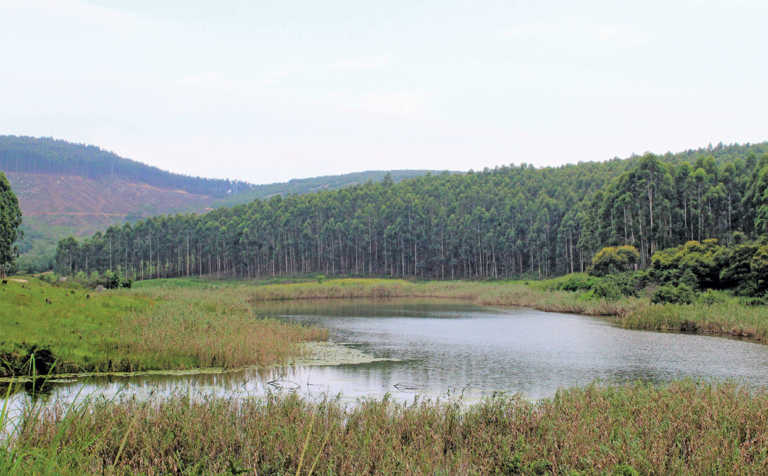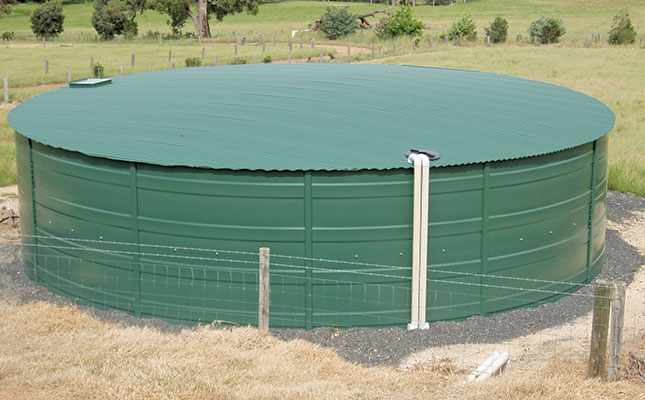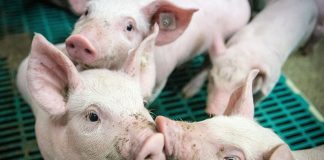
Photo: Lindi Botha
Severe water restrictions across the country, along with crumbling municipal infrastructure, debilitating drought and the pollution of water reserves, have left many farmers with little choice: they must make the most of the water they have.
Soil management, rainwater harvesting and proper storage of water all affect how efficiently farmers make use of water resources.
While agriculture consumes about 75% of the rainfall in South Africa, 60% is utilised by natural vegetation, 12% by dryland crop production and 3% by irrigation. It is therefore imperative that this rain is used optimally and every drop put to good use.
Rainwater harvesting
South Africa receives an average annual rainfall of 495mm. This is less than half of the world’s average of 1 033mm.
In fact, South Africa is one of the 20 most water-scarce countries in the world. Since 98% of the freshwater resources in South Africa are already considered fully allocated, on-farm rainwater harvesting is crucial to keep irrigation systems running.
Hylton Cruse, Mpumalanga sales agent for water storage tank supplier Rainbow Reservoirs, says that farmers should assess their water needs and make provision for storage capacity before the rainy season to capitalise on every drop.
He says the best place to initiate rainwater harvesting is the roofs of buildings. “A house or outbuilding with a roof surface area of 1 500m² can save 1 500ℓ of water for every millimetre of rainfall.

If you live in a low-rainfall area, with an average annual rainfall of 500mm, you could save 750 000ℓ of water a year.
This could put you so much closer to your irrigation requirement goal. During the dry months, it could be the difference between your operation surviving another year or not.”
Concrete gullies can be used to channel rainwater into reservoirs placed at the lower end of the farm.
Cruse notes that rainwater is free of chemicals, and its optimal use on farms lessens the depletion of catchment reservoirs, reduces the demand on groundwater, and helps prevent soil erosion by reducing peak stormwater run-off. Best of all, it’s free.
Optimise stored water
Studies conducted by the Water Research Commission have found that South Africa has lost a quarter of its water storage capacity due to sedimentation.
Many dams are now full and have lost their trapping capacity, while others have breached and are beginning to lose their sediment downstream.
Cruse says that for this reason it is important to ensure that farm dams remain sediment-free to ensure the full capacity of infrastructure is available.
“Consider installing reservoirs with filtration systems that keep the sand out or allow for any sediment to be removed. These reservoirs have scour drains shaped like cones, so 35 and is collected at the bottom of the reservoir. This should be flushed out at least once a year.”
While groundwater dams have the advantage of volume, their evaporation area is greater and the dam takes up more space on the farm that could have been used to plant crops.
“Reservoirs are beneficial in that you can quickly increase water storage capacity. Covered reservoirs also minimise evaporation and algae formation. The advantage of having a covered reservoir is that the lining isn’t exposed to any sun, so it lasts longer. Algae can’t grow in the dark, so your irrigation system is less likely to get clogged,” says Cruse.
He adds that farmers should systematically replace concrete dams with steel tanks to save water and cost in the long run.
“The steel wall structure cannot crack, and cracking is the greatest cause of leakage in cement dams.”
Maintain water quality
Apart from quantity, quality of water is important, yet it is seldom considered on farms. Dr Heinz Meissner, programme director for research and development at Milk South Africa, notes it is important that effective measures be implemented to ensure water is free of contaminants.
“Water tests should be done regularly for microbiological and chemical contents to ensure the water complies with specifications. All water sources, such as borehole, river and canal water, should be tested.
“Where water is chlorinated on site, a routine checking procedure should be implemented. Storage tanks and reservoirs for water must be covered to prevent contamination by birds, rodents, and organic or inorganic matter. Air vents should also be insect and rodent-proof.”
Meissner adds that where there is effluent, such as from an on-farm feedlot, it should be managed appropriately to ensure effective disposal, and that no water sources are contaminated.
“If the effluent is applied to pasture, there should be a lapse of at least 21 days between application and grazing or harvesting of the pasture. In addition, if the effluent is collected and spray-irrigated from a storage system, the homestead and vicinity should not be exposed to spray drift.”
Manage run-off
Meissner says that to take advantage of rain, the farmer should ensure there is no excessive run-off, as this results in soil erosion and poor water infiltration.
The objective should be to optimise both green and blue water.
“The natural vegetation [veld] and dryland crop production use only ‘green water’, which is rainwater stored in the soil after precipitation. Green water supplies the moisture that natural pastures require to grow and produce fodder for animals kept under extensive grazing conditions.
The veld, he explains, does not generally utilise blue water, which is run-off water to streams, dams and other storage infrastructure, or water stored in underground aquifers and often recovered from boreholes.
“This makes it all the more important to ensure that the green water is absorbed optimally on the farm to provide the most benefit. With the short, heavy downpours caused by climate change, more water will flow away unutilised, and together with higher temperatures, there will be more evaporation.”
The net effect could be less effective rainfall if rainfed water [both green and blue water] is not well managed.
Meissner advises the following measures to optimise rainfall: Catchment areas on farms should become storage areas using both mechanical means, such as weir construction, and vegetative means, by creating wetlands in catchment areas. The latter can be established by planting reeds and tough grasses adapted to the region.
Vegetative cover in rangelands is the most important factor. This ensures that rainwater that otherwise would have flowed away is captured and utilised effectively for plant growth.
It also implies that blue water becomes green water. Vegetative cover is primarily determined by grazing capacity and stocking rate; conservative stocking rates and comparatively long resting periods of camps have the most significant effect on plant cover [even more than the variation in rainfall].
A conservative stocking rate refers to the farm in total and does not mean that a farmer should not have more animals than the calculated stocking rate in the camp presently grazed.
In fact, intensive grazing under particular environmental conditions can be a good option as it provides more manure and assists in breaking up the topsoil by trampling.
This supports moisture penetration, seeding and seed germination through helping to improve the organic status of the soil. However, the grazing period should be short and the resting period long to ensure recovery and sufficient vegetative growth.
In mixed farming systems where livestock farmers also produce crops, minimum tillage should become the norm, as it ensures more organic matter, which leads to better water capture and usage.
Phone Hylton Cruse on 083 702 0357, or email Dr Heinz Meissner at [email protected].











